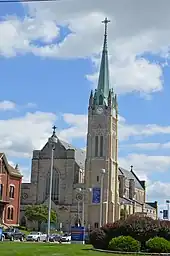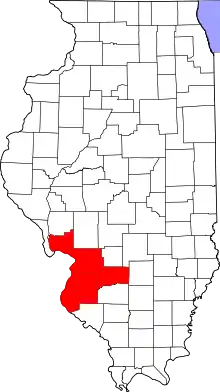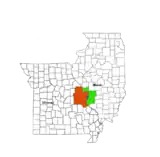Belleville, Illinois | |
|---|---|
 | |
 Flag | |
 | |
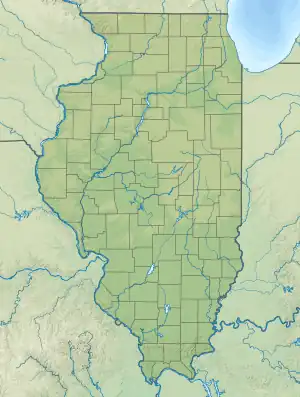 Belleville  Belleville | |
| Coordinates: 38°31′18″N 89°59′43″W / 38.52167°N 89.99528°W | |
| Country | |
| State | |
| County | |
| Founded | 1814 |
| Government | |
| • Mayor | Patty Gregory |
| Area | |
| • Total | 23.49 sq mi (60.84 km2) |
| • Land | 23.23 sq mi (60.17 km2) |
| • Water | 0.26 sq mi (0.67 km2) |
| Elevation | 502 ft (153 m) |
| Population (2020) | |
| • Total | 42,404 |
| • Density | 1,825.16/sq mi (704.71/km2) |
| Time zone | UTC−6 (CST) |
| • Summer (DST) | UTC−5 (CDT) |
| ZIP code(s) | 62220-62223, 62225, 62226 |
| Area code | 618 |
| FIPS code | 17-163-04858 |
| GNIS feature ID | 2394118[2] |
| Website | belleville.net |
Belleville is a city and the county seat of St. Clair County, Illinois, United States.[3] It is located within Greater St. Louis. The population was 42,404 at the 2020 census, making it the most-populated city in Southern Illinois and in the Metro East region of Greater St. Louis. Due to its proximity to Scott Air Force Base, the population receives a boost from military and federal civilian personnel, defense contractors, and military retirees. It is also the seat of the Roman Catholic Diocese of Belleville and the National Shrine of Our Lady of the Snows.
History
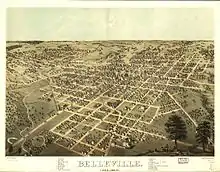
George Blair named the city of Belleville in 1814. Because Blair donated an acre of his land for the town square and an additional 25 acres (10 ha) adjoining the square for the new county seat, the legislature transferred the county seat from the village of Cahokia. The latter had been established by French colonists as a mission village in the late 17th century.
Belleville was incorporated as a village in 1819, and became a city in 1850. It is said that Blair originally named the city Bellville in honor of Tennessee politician John Bell. In 1863, the name was officially changed to Belleville to distance the city from the now-disgraced Confederate.[4] Major immigration in the mid-19th century to this area occurred following revolutions in Germany, and most of the European-American population is of German ancestry.
Many of the educated Germans fled their homeland after the failure of the German Revolution in 1848. Belleville was the center of the first important German settlement in Illinois. By 1870, an estimated 90% of the city's population was either German-born or of German descent.[5]
After the Civil War, Belleville became a manufacturing center producing nails, printing presses, gray iron castings, agricultural equipment, and stoves. Belleville became known as "The Stove Capital of the World." The first brewery in Illinois was established in Belleville. In 1868, Gustav Goelitz founded the candy company that is known today as "Jelly Belly."[5]
An immense deposit (400,000 acres (1,600 km2)) of bituminous coal was found in St. Clair County. By 1874, some farmers had become coal miners. One hundred shaft mines were in operation in and around Belleville. The coal brought the steam railroad to town, which allowed for the transport of many tons of coal to be shipped daily from Belleville to St. Louis on the west side of the Mississippi River, for use in its industries, homes and businesses. Later, Belleville had the first electric trolley in the state.[5]

The first style of houses in Belleville were simple brick cottages, known locally as "German street houses" or "row houses." Architectural styles flourished in greater variety, featuring American Foursquare, French Second Empire, Greek Revival, Gothic Revival, Italianate, Queen Anne, and Victorian.[6] The Belleville Historic District, which was listed on the National Register of Historic Places in 1976, comprises 73 contributing properties.[7]
The "Old Belleville Historic District," was defined and recognized in 1974 and is the city's first historic district.[6] The city also has designated two more historic districts: "Hexenbuckel" (est. in 1991) and "Oakland" (est. in 1995).[8]
Belleville's early German immigrants were educated, with most of them having graduated from German universities. They were nicknamed "Latin Farmers" because of this. After 1836 Gustav Koerner contributed to establish the city's public library. The Belleville Public Library is the state's oldest, predating the Illinois State Library by three years. The German settlers also founded choral and dramatic groups, as well as literary societies. They established one of the first kindergartens in the country here.[5][6]
In 1990, as reported by the Belleville News-Democrat using the US Census data, the city surpassed the neighboring city of East St Louis to become the most populated city in the Metro East and Southern Illinois.[9]
The National Civic League recognized Belleville in 2011 as one of the ten recipients of the All-America City Award. Belleville is coterminous with the now defunct Belleville Township.[10]
In 2021, residents of the Illinois city elected Patty Gregory as Belleville's first female Mayor.[11][12]
Geography
Belleville is located at 38°31′18″N 89°59′43″W / 38.52167°N 89.99528°W (38.521567, −89.995208).[13]
According to the 2010 census, Belleville has a total area of 23.49 square miles (60.84 km2), of which 22.74 square miles (58.90 km2) (or 98.83%) is land and 0.269 square miles (0.70 km2) (or 1.17%) is water.[14] Richland Creek flows through much of Belleville.
Climate
| Climate data for Belleville SIU Research, Illinois (1991–2020 normals, extremes 1948–present) | |||||||||||||
|---|---|---|---|---|---|---|---|---|---|---|---|---|---|
| Month | Jan | Feb | Mar | Apr | May | Jun | Jul | Aug | Sep | Oct | Nov | Dec | Year |
| Record high °F (°C) | 75 (24) |
83 (28) |
89 (32) |
91 (33) |
97 (36) |
106 (41) |
110 (43) |
105 (41) |
103 (39) |
96 (36) |
84 (29) |
77 (25) |
110 (43) |
| Mean maximum °F (°C) | 64.0 (17.8) |
70.2 (21.2) |
78.6 (25.9) |
84.7 (29.3) |
89.8 (32.1) |
95.2 (35.1) |
97.3 (36.3) |
96.8 (36.0) |
93.5 (34.2) |
87.3 (30.7) |
75.2 (24.0) |
65.5 (18.6) |
98.8 (37.1) |
| Mean daily maximum °F (°C) | 42.9 (6.1) |
48.6 (9.2) |
59.2 (15.1) |
70.6 (21.4) |
79.1 (26.2) |
87.3 (30.7) |
90.2 (32.3) |
89.1 (31.7) |
83.3 (28.5) |
72.6 (22.6) |
58.1 (14.5) |
46.3 (7.9) |
68.9 (20.5) |
| Daily mean °F (°C) | 33.6 (0.9) |
38.3 (3.5) |
47.8 (8.8) |
58.3 (14.6) |
67.7 (19.8) |
75.9 (24.4) |
79.0 (26.1) |
77.2 (25.1) |
70.1 (21.2) |
59.7 (15.4) |
47.5 (8.6) |
37.3 (2.9) |
57.7 (14.3) |
| Mean daily minimum °F (°C) | 24.3 (−4.3) |
28.0 (−2.2) |
36.3 (2.4) |
46.0 (7.8) |
56.3 (13.5) |
64.5 (18.1) |
67.8 (19.9) |
65.3 (18.5) |
56.9 (13.8) |
46.7 (8.2) |
36.9 (2.7) |
28.3 (−2.1) |
46.4 (8.0) |
| Mean minimum °F (°C) | 1.7 (−16.8) |
8.6 (−13.0) |
16.3 (−8.7) |
28.7 (−1.8) |
39.7 (4.3) |
50.7 (10.4) |
56.5 (13.6) |
53.4 (11.9) |
40.3 (4.6) |
27.8 (−2.3) |
18.0 (−7.8) |
8.4 (−13.1) |
−1.8 (−18.8) |
| Record low °F (°C) | −27 (−33) |
−21 (−29) |
−8 (−22) |
18 (−8) |
28 (−2) |
38 (3) |
43 (6) |
39 (4) |
26 (−3) |
20 (−7) |
2 (−17) |
−19 (−28) |
−27 (−33) |
| Average precipitation inches (mm) | 2.56 (65) |
2.16 (55) |
3.44 (87) |
4.90 (124) |
5.05 (128) |
4.62 (117) |
4.03 (102) |
3.92 (100) |
3.35 (85) |
3.12 (79) |
3.60 (91) |
2.61 (66) |
43.36 (1,101) |
| Average snowfall inches (cm) | 3.4 (8.6) |
3.3 (8.4) |
1.0 (2.5) |
0.0 (0.0) |
0.0 (0.0) |
0.0 (0.0) |
0.0 (0.0) |
0.0 (0.0) |
0.0 (0.0) |
0.0 (0.0) |
0.6 (1.5) |
2.9 (7.4) |
11.2 (28) |
| Average precipitation days (≥ 0.01 in) | 7.1 | 7.5 | 9.5 | 10.3 | 11.5 | 8.7 | 7.4 | 7.2 | 6.6 | 8.4 | 7.7 | 7.7 | 99.6 |
| Average snowy days (≥ 0.1 in) | 2.2 | 1.9 | 0.6 | 0.0 | 0.0 | 0.0 | 0.0 | 0.0 | 0.0 | 0.0 | 0.4 | 1.9 | 7.0 |
| Source: NOAA[15][16] | |||||||||||||
Demographics
| Census | Pop. | Note | %± |
|---|---|---|---|
| 1850 | 2,941 | — | |
| 1860 | 7,520 | 155.7% | |
| 1870 | 8,146 | 8.3% | |
| 1880 | 10,683 | 31.1% | |
| 1890 | 15,361 | 43.8% | |
| 1900 | 17,484 | 13.8% | |
| 1910 | 21,122 | 20.8% | |
| 1920 | 24,823 | 17.5% | |
| 1930 | 28,425 | 14.5% | |
| 1940 | 28,405 | −0.1% | |
| 1950 | 32,721 | 15.2% | |
| 1960 | 37,264 | 13.9% | |
| 1970 | 41,223 | 10.6% | |
| 1980 | 41,580 | 0.9% | |
| 1990 | 42,785 | 2.9% | |
| 2000 | 41,410 | −3.2% | |
| 2010 | 44,478 | 7.4% | |
| 2020 | 42,404 | −4.7% | |
| U.S. Decennial Census[17][18] | |||
At the 2000 census there were 41,410 people, 17,603 households, and 10,420 families living in the city. The population density was 2,196.4 inhabitants per square mile (848.0/km2). There were 19,142 housing units at an average density of 1,015.3 per square mile (392.0/km2). The racial makeup of the city was 81.51% White, 15.51% African American, 0.26% Native American, 0.81% Asian, 0.07% Pacific Islander, 0.41% from other races, and 1.43% from two or more races. Hispanic or Latino of any race were 1.63%.[19]
Of the 17,603 households 28.4% had children under the age of 18 living with them, 42.0% were married couples living together, 13.5% had a female householder with no husband present, and 40.8% were non-families. 35.1% of households were one person and 14.0% were one person aged 65 or older. The average household size was 2.27 and the average family size was 2.95.
The age distribution was 23.4% under the age of 18, 9.0% from 18 to 24, 30.3% from 25 to 44, 20.1% from 45 to 64, and 17.2% 65 or older. The median age was 37 years. For every 100 females, there were 88.9 males. For every 100 females age 18 and over, there were 85.0 males.
The median household income was $35,979 and the median family income was $46,426. Males had a median income of $33,361 versus $25,375 for females. The per capita income for the city was $18,990. About 9.3% of families and 11.7% of the population were below the poverty line, including 16.2% of those under age 18 and 9.3% of those age 65 or over.
2010 Census
As of the 2010 Census, there were 44,478 people, 18,795 households, 11,081 families living in the city. The population density was. The racial makeup of the city was 69.8% White, 25.4% African American, 0.3% Native American, 1.0% Asian, 0.1% Pacific Islander, 0.6% from other races, and 2.8% from two or more races. Hispanic or Latino of any race were 2.6% of the population
Of the 18,795 households 27.7% had children under the age of 18 living with them, 38% were married couples living together, 16.4 had a female householder with no man present, and 41% were non-families. 34.4% of households were one person and 10.8% had someone living alone who was 65 years of age of older. The average household size was 2.3 and the average family size was 2.9.
The age distribution was 23.3% under the age of 18, and 12.9% over the age of 65.[20]
Arts and culture
The Belleville Philharmonic Society was formed in 1866, making it the second oldest philharmonic orchestra in the country.[21] With the increase in black population and migrants from the South, musicians developed who played blues and jazz; later rock clubs were added to the scene.
Jay Farrar (now of Son Volt), Mike Heidorn, and Jeff Tweedy (now of Wilco) of the now-defunct alt country group Uncle Tupelo are from Belleville. Another major musician was Neal Doughty, keyboardist for 1970s rock band REO Speedwagon. The rock band Redding also hails from Belleville, with the members being childhood friends there. They then went on to work from the entertainment and shopping company Vat19.
National Register of Historic Places
Sports
- Rowdies Rugby Football Club – the only rugby football club in the Belleville area.
- Lindenwood Stadium is a college football stadium with alternating red and gray stripes. It has been called "The nation's most original (hideous) football field."[22]
- Belleville was home to the Belleville Stags (1947–1949), who were a minor league baseball team. The Stags were charter members of the Illinois State League and remained when the league changed names to the Mississippi–Ohio Valley League in 1949, eventually becoming today's Midwest League in 1956. The Stags played at the Belleville Athletic Field and were named and supported by their namesake, Stag Beer. The Stags were an affiliate of the New York Yankees (1949) and St. Louis Browns (1947–1948).[23]
Education
Higher education:
- The Saint Louis University Family Medicine Residency
- Lindenwood University – Belleville
- Southwestern Illinois College
Within the city there are four high schools – two public (Belleville High School-East, Belleville High School-West), and two private (Althoff Catholic High School, Governor French Academy). In addition, small portions of the city are within the districts for East St. Louis Senior High School, Mascoutah High School, and Freeburg High School.
Belleville is also home to a relatively large grade school district. Belleville District 118 has 9 elementary schools, (Roosevelt, Abraham Lincoln, Douglas, Franklin, Jefferson, Union, Westhaven, Henry Raab, and Washington) and 2 junior high schools (Central Junior High and West Junior High). Belle Valley School District 119 is also available for public school. Harmony School District 175 includes Ellis Elementary and Emge Jr. High. Signal Hill School is the only school in district 181. Whiteside Elementary School and Whiteside Middle School make up district 115. Parochial grade schools include St. Peter's Cathedral, St. Augustine of Canterbury Church, St. Teresa, Blessed Sacrament, Our Lady Queen of Peace, and Zion Lutheran School.[24]
Media
The Belleville News-Democrat, is the city's daily newspaper. The News-Democrat is part of the McClatchy chain and covers the Metro East region and Southwestern Illinois. The city is also served by the St. Louis Post-Dispatch, the area's major metropolitan daily. Belleville receives the signals of most radio and TV stations based in St. Louis.
Transportation

Belleville has three St. Louis MetroLink stations connecting it to St. Louis and the network via light rail: Memorial Hospital, Belleville, and College.
Illinois State Highways 15, 158, 159, 177, 13 and 161 all pass through Belleville. Belleville is also adjacent to Interstate highways 64 and 255. I-64 is an east–west highway extending from Wentzville, Missouri to Virginia Beach, Virginia and is the major route from Belleville to downtown St. Louis. I-255 is part of a system of expressways that together form a loop around St. Louis.
Belleville has a bicycle trail that runs through the city from Southside Park to Southwestern Illinois College and Scott Air Force Base; it is mainly used for recreational purposes.
Belleville's area airports are Scott Air Force Base and MidAmerica St. Louis Airport, which is served by Allegiant Air. The nearest major airport with regularly scheduled commercial passenger service is St. Louis Lambert International Airport.
Healthcare
Bethany Place in Belleville provides services for those with HIV/AIDS.[25][26][27][28]
Notable people

- Black Beaver (1806–1880), Delaware Native American leader, scout, and rancher
- Charles Romyn Dake, 19th-century American homeopathic physician and writer
- Lea DeLaria, American comedian, actress, and jazz singer
- Buddy Ebsen, American actor and dancer
- Jay Farrar, American songwriter and musician
- Mary Lynne Gasaway Hill, poet, writer, professor at St. Mary's University, Texas and Fellow of the Royal Society of Arts[29]
- Bob Goalby, Professional golfer, winner of the 1968 Masters Tournament
- Sandra Magnus, American engineer and a former NASA astronaut
- Darius Miles, former American professional basketball player
- James T. Mitchell (1834-1915), chief justice of the Supreme Court of Pennsylvania
- Edward P. Petri, Illinois state representative, sheriff, and businessman
- Mary Ellen Richmond, constructed the foundations for the scientific methodology development of professional social work and is considered as the mother of social casework.[30]
- Jeff Tweedy, musician, songwriter, author, and record producer
- Kevin Von Erich, an American retired professional wrestler
- Stephen R. Wigginton, U.S. Attorney for the Southern District of Illinois from 2010 to 2015.[31]
Sister city
Belleville has one sister city:
References
- ↑ "2020 U.S. Gazetteer Files". United States Census Bureau. Retrieved March 15, 2022.
- 1 2 U.S. Geological Survey Geographic Names Information System: Belleville, Illinois
- ↑ "Find a County". National Association of Counties. Archived from the original on July 12, 2012. Retrieved June 7, 2011.
- ↑ Hallowell, Zechariah (1865). History of St. Clair County, Illinois: A Compendium of Its Villages, Townships and Cities and Their Nomenclature. Z.A. Hallowell. p. 131.
- 1 2 3 4 "Labor and Industry Museum", Labor and Industry Museum: Belleville History, accessed 1 December 2010]
- 1 2 3 "Village Profile", Village Profile: History and Culture, 1997, accessed 1 December 2010]
- ↑ "National Register Information System". National Register of Historic Places. National Park Service. July 9, 2010.
- ↑ "Labor and Industry Museum", Labor and Industry Museum: Other Historic Resources, accessed 1 December 2010
- ↑ https://www.newspapers.com/article/the-belleville-news-democrat-belleville/131983526/
- ↑ "Belleville officially takes over township's duties". bnd. Retrieved September 7, 2017.
- ↑ Koziatek, Mike (April 7, 2021). "Gregory looks forward to serving as first female mayor in Belleville's 207 years". Belleville News and Democrat. Retrieved April 7, 2021.
- ↑ Benchaabane, Nassim (April 7, 2021). "Maplewood, Alton elect first Black mayors; Belleville elects first woman mayor in upsets to local incumbents". St. Louis Dispatch. Retrieved April 7, 2021.
- ↑ "US Gazetteer files: 2010, 2000, and 1990". United States Census Bureau. February 12, 2011. Retrieved April 23, 2011.
- ↑ "G001 - Geographic Identifiers - 2010 Census Summary File 1". United States Census Bureau. Archived from the original on February 13, 2020. Retrieved December 25, 2015.
- ↑ "NowData – NOAA Online Weather Data". National Oceanic and Atmospheric Administration. Retrieved July 24, 2021.
- ↑ "Station: Belleville SIU RSCH, IL". U.S. Climate Normals 2020: U.S. Monthly Climate Normals (1991–2020). National Oceanic and Atmospheric Administration. Retrieved July 24, 2021.
- ↑ "Census of Population and Housing". Census.gov. Retrieved June 4, 2016.
- ↑ "U.S. Census Bureau QuickFacts: Belleville city, Illinois". www.census.gov. Retrieved January 3, 2020.
- ↑ "U.S. Census website". United States Census Bureau. Retrieved January 31, 2008.
- ↑ "Belleville, Illinois". United States Census Bureau. Retrieved October 28, 2018.
- ↑ Belleville Philharmonic Society Symphony Orchestra Archived November 11, 2007, at the Wayback Machine
- ↑ Watson, Graham (July 11, 2012). "NAIA school unveils the nation's most original football field". Yahoo Sports. Retrieved September 7, 2012.
- ↑ "Belleville, Illinois Encyclopedia". Baseball-Reference.com.
- ↑ "St. Clair County Regional Office of Education" Archived February 21, 2009, at the Wayback Machine, St. Clair County Regional Office of Education, 12/2010, accessed 15 December 2010
- ↑ Michael O'Loughlin (December 29, 2019). "A Catholic Sister learns to serve people with AIDS". Plague: Untold Stories of AIDS & the Catholic Church (Podcast). America. Retrieved January 10, 2019.
- ↑ O'Loughlin, Michael (January 21, 2019). "The Catholic Nun Who Came to New York to Confront the AIDS Crisis". Retrieved January 10, 2019.
- ↑ Freeman, Brittany (November 20, 2014). "Bethany Place provides a new kind of home". Retrieved January 10, 2019.
- ↑ Weichert, Heidi (December 30, 2017). "Bethany Place assists metro-east residents who have HIV or AIDS". Belleville News-Democrat. Retrieved January 10, 2019.
- ↑ "English professor named Fellow of the Royal Society for the Encouragement of Arts, Manufactures and Commerce". St. Mary’s University, Texas on June 24, 2020. June 24, 2020. Retrieved October 12, 2021.
- ↑ "Mary Ellen Richmond (1861-1928) – Social Work Pioneer, Administrator, Researcher and Author". January 21, 2011. Retrieved January 26, 2023.
- ↑ Dionne, Matthew S. "Someone you should know: Stephen R. Wigginton, United States Attorney for the Southern District of Illinois". The Public Servant. Illinois State Bar Association. 14 (2).
- ↑ Belleville Sister Cities, Inc Archived March 24, 2008, at the Wayback Machine is the organization which fosters the relationship between the two cities.
External links
- Official website
- The Belleville Historical Society
- "Belleville Bicentennial Celebration". City of Belleville, Illinois. 2013. Archived from the original on September 5, 2014.
